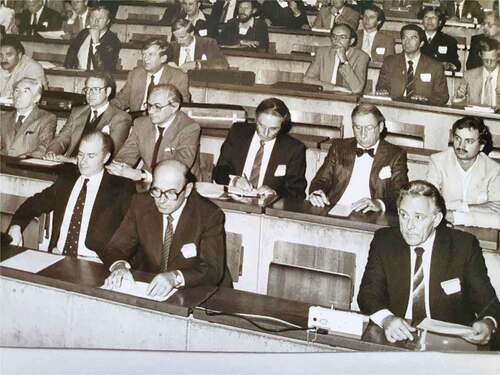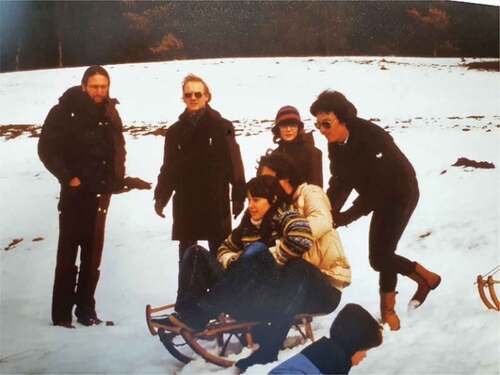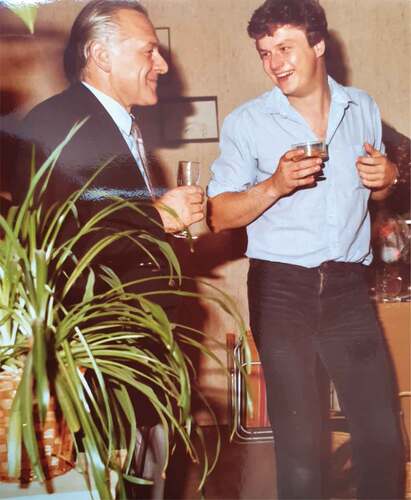PREFACE
The paper contains the author’s personal account of the professional achievements of Professor Friedrich (Fritz) Ackermann based on the author’s memories and private documents which demonstrate Ackermann’s significant influence throughout various professional phases over a period of four decades. The structure of the paper is based on the path of the author’s studies, the period as a member of the Institute of Photogrammetry at Stuttgart University, and finally, a professional career in photogrammetry, geoinformation and management. The emphasis is on the character and skills of Friedrich Ackermann. Profession, team spirit and social skills are demonstrated with impressive examples.
1. Introduction
This article contains the author’s very personal view on his experience during his professional career in the field of photogrammetry and the influence of Fritz Ackermann.
There are three phases demonstrating more or less the common development of a photogrammetric engineer in those days. The challenging transformation from analogue to analytical, and finally to digital procedures were fascinating for both system suppliers and for users, all driven by the IT developments in hard- and software. Opportunities were opened and people like Fritz Ackermann had seen them in their research long before they could be realized in practical applications.
2. Studies of Geodesy at University of Stuttgart
In the years 1972 to 1977 I studied the discipline of Geodesy at Stuttgart University. During the first half of the studies, I only had limited contact to the Institute of Photogrammetry led by Professor Fritz Ackermann. But members of the Institute giving lectures to young students began showing a different spirit. Lectures in statistics and error propagation by Karl Kraus (Kraus Citation1973, Citation2022) were certainly memorable.
The second half of my studies of Geodesy were strongly influenced by the lectures and exercises given by Fritz Ackermann and his team in photogrammetry, incl. aerial triangulation, differential photo rectification, etc. The main focus was on analytical and numerical photogrammetry. His easy way of explaining complex context was fascinating for us students. He was able to visualize all theoretical approaches using practical examples from scientific investigations or from users.
Fritz Ackermann also liked to keep contact to his students. By the end of our studies, he regularly invited the whole year for a dinner party at his house where we discussed many topics, not only related to the field of our profession.
An interruption during my probation period as legal surveyor of more than two years did not break my contact to the Institute due to friends working there. At the end of that period, Fritz Ackermann offered me a position as scientific assistant in place of Matthäus Schilcher (Schilcher Citation2022) who then started his career in private industry.
3. Scientific assistant at the Institute of Photogrammetry
A friendly and very familiar atmosphere governed the Institute of Photogrammetry under the leadership of Fritz Ackermann. I was employed in the period from 1979 until 1984, assisting in lecturing in the field of adjustment theory, research, and to write my PhD thesis. Small industrial developments helped me to better understand the theoretical approaches (e.g. Schroth Citation1982).
At the commencement of my new employment, I was directly involved into the preparations of the famous biennial Photogrammetric Week. In 1979, Fritz Ackermann gave me the responsibility of organizing the exhibition, together with the management, editing and publishing of the presented papers for the institute’s publishing series, e.g. Ackermann (Citation1980). I actively participated in the organization of two further Photogrammetric Weeks (see ) until 1983. I never missed a Photogrammetric Week thereafter. Fritz Ackermann also participated every year until 2019, his last opportunity.
Besides the Photogrammetric Week, it was a regular practice under Ackermann to offer training courses from the institute for professionals from public agencies and industry to keep updated with scientific and research topics, e.g. (Ackermann Citation1981). This was long before the popular term of “lifelong learning” was introduced in the 1990’s. Ackermann’s ability to lead surprised me, particularly when he stated that I was to take over the presentation for one of these training courses only after four months at the institute. His evaluation of the skills of his staff was fascinating, and so he just trusted even a beginner.
My main task at the institute was assisting Fritz Ackermann during his lectures in adjustment theory, taking over parts of these, preparing and evaluating exercises for the students, and also the final written examinations.
It was also common practice for the students to present their results of some research work in front of an audience (students, members of the institute’s, etc.). After each presentation, a public evaluation was made by the heads of the institutes. During one of these so-called “seminars”, a student gave a technically correct presentation but not particularly eloquent. The student’s style of presentation was heavily criticized by one of Ackermann’s colleagues from the north of Germany. Fritz could not let it stand like this and defended the student by telling his colleague that here in the southwest of Germany the people are not fluent speakers by nature and that it is very hard for them. The colleague replied that the famous first president of the German Federal Republic, Mr. Theodor Heuss, came from the vicinity of Stuttgart and that he was an excellent speaker. Fritz answered: You see, he immediately became President of Germany!
For the preparation of my PhD thesis, based on a proposal from Wolfgang Förstner (Förstner Citation2022), Ackermann gave me a lot of freedom, just guiding me remotely with advice and proposals. Although never directly involved, objectiveness and guidance were his methods. It was his typical style of “laissez faire” leadership, leading by guiding but with situation-based decision making. This describes his leadership best in terms of modern management styles. Later in our professional careers, most of Ackermann’s former staff members used this kind of leadership, as I have observed.
I have already mentioned the familiar atmosphere at the institute. There were regular social events with members of the institute and their families, such as joint skiing in the Alps or parties at Fritz’ summer house in the Black Forrest, see . These types of events are nowadays called “team buildings” but this happened decades before these HR methods were invented.
In Germany, scientific assistants have contracts of limited duration. In 1984, I followed the proposal from Ackermann to take over an engineering position at a German aerial survey company in the northwest.
4. Further cooperation with the institute and INPHO
I started my new employment with the responsibility for aerial triangulation and orthophoto production. As requested by the employer, we purchased the software PAT M for aerial triangulation with models and SCOP for DTM processing, both from INPHO Stuttgart. The company INPHO GmbH was a spin-off of the institute, and was founded by Fritz Ackermann and different shareholders at the time. We had training courses headed by members of the institute and the full institute organized an excursion to visit us in Münster/Westfalen and also at ITC in Enschede (The Netherlands). It was a pleasure for me to invite the whole team to my home – just another team building event.
Later on we also purchased the software PAT B for aerial triangulation with bundles. So, the link to the institute and to INPHO went on over many years, also continuing after Fritz Ackermann retired from his position as head of the institute. Together, we have made aerial survey flights for various tests.
The contacts to INPHO also remained intact. Ackermann’s idea was to share responsibilities with his employees, and so he offered most of them a partnership as a shareholder in the company. This was not easy for the management of such a limited liability company, as most of the decisions had to be made at a permanent shareholder meeting. This situation was discussed several times throughout the years, especially when, in the meantime, I was responsible for the management of many international companies in our field of business.
In 2003, we together founded a research and development company called CONPIE GmbH, located close to Stuttgart, with the focus on digital camera techniques and automatic processing for the total workflow from data capture to the finished digital orthophoto.
My passion for lecturing during the time at the institute was strongly influenced by Ackermann. Parallel to my various management positions throughout my professional career, I managed to continuously teach, in the years 1991 until 2019, at the Leibniz University in Hannover, the Polytechnic University in Barcelona and the Hochschule für Technik in Stuttgart.
5. Closing remarks
With the passing of Professor Fritz Ackermann, we have lost a great personality, not only in our profession. Fortunately, his ideas, his style of leadership, his scientific developments are living on and are being passed on by generations of his students and scientific team members at the institute, and through his private enterprise.
Disclosure statement
No potential conflict of interest was reported by the author.
References
- Ackermann, F. 1980. Proceedings of the 37th Photogrammetric Week at Stuttgart University. Schriftenreihe des Instituts für Photogrammetrie der Universität Stuttgart, Heft 6. https://phowo.ifp.uni-stuttgart.de/publications/phowo79/ackermann.pdf.
- Ackermann, F. 1981. Vorträge des Lehrgangs numerische Photogrammetrie (IV) an der Universität Stuttgart über “Grobe Datenfehler und die Zuverlässigkeit der photogrammetrischen Punktbestimmung”. Schriftenreihe des Instituts für Photogrammetrie der Universität Stuttgart, Heft 7. https://ifpwww.ifp.uni-stuttgart.de/publications/1981-1990/ackermann2.pdf.
- Förstner, W. 2022. https://de.wikipedia.org/wiki/Wolfgang_Förstner.
- Kraus, K. 1973. Manuscript about Error Propagation. unpublished.
- Kraus, K. 2022. https://de.wikipedia.org/wiki/Karl_Kraus_Geodät.
- Schilcher, M. 2022. https://de.wikipedia.org/wiki/Matthäus_Schilcher.
- Schroth, R. 1982. Rechnergestützte kartographische Entzerrung mit Reproduktionskameras. Kartographische Nachrichten, Heft 3/82, S. 81-86.



